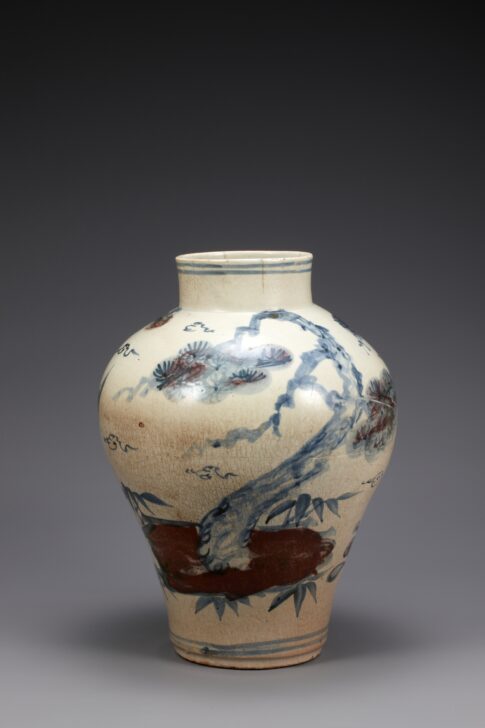Blue-and-white balustrade jar with design of stag, crane, and pine tree
Korean

Description
This Korean jar is porcelain, which requires a special type of clay and a kiln capable of very high temperatures. Korea has an abundance of fine-grained clay suitable for porcelain wares. Inspired by Chinese blue-and-white ceramics, Korean potters made use of both rare imported cobalt (for blue) and local iron and copper (for brown and red) to produce pigments for underglaze painting. But while Chinese potters preferred tightly organized patterns, in Korean pots exuberant pictorial designs cover the entire surface of the vessel. The vocabulary of motifs is uniquely Korean as well: here, every plant and animal is an auspicious symbol of longevity.
Choson dynasty porcelains were much appreciated in Japan for their robust shapes and the powerful, spontaneous drawing of the underglaze designs.
Exhibited in "Japanese Costumes & Ceramics, Past & Present," October 2001-February 2002. Maribeth Graybill, Senior Curator of Asian Art
Subject Matter:
This body shape has prevailed the entire Joseon period but the tall mouth is a unique end Joseon feature. The parallel use of these two colors started in the late 18th century to continue into the following century, and seem to have been influenced by colorful folk painting.
Physical Description:
This jar has a long and upright mouth with a robust shoulder that give way to a body tapering toward the base. The crane, cloud, pine tree and rock are painted with blue and red copper pigment.
This jar was produced at a kiln in Bunwon-ri, Gwangju-si, Gyeonggi-do after the privatization of official court kilns in 1883. Ten longevity symbols, including pine trees, rocks, lingzhi fungus, deer, cranes, clouds and bamboo, are decorated in cobalt-blue and copper-oxide pigment was used in parts to decorate the jar. Such jars featuring the ten longevity symbols were often used at events such as elder statesmen’s gathering (giroyeon) and 60th birthday parties (hoegabyeon). Crackles were formed on the mouth and body, which are contaminated with impurities, but it remains intact overall. The foot retains traces of coarse sand supports, but lots of cracks were formed.
[Korean Collection, University of Michigan Museum of Art (2014) p.169]
Usage Rights:
If you are interested in using an image for a publication, please visit https://umma.umich.edu/request-image/ for more information and to fill out the online Image Rights and Reproductions Request Form.